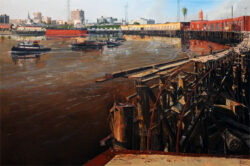Simon Gunning
Louisiana artist Simon Gunning is best known for his gritty depictions of the Mississippi River.

Courtesy of Michael Wilkinson
Condemned. Gunning, Simon (Artist)
Australia-born Simon Ben Patterson Gunning has gained a considerable following for his gritty paintings of the New Orleans riverfront and the broad, grassy delta of the Mississippi River as it enters the Gulf of Mexico.He has an edgy style of painting the South Louisiana landscape that is almost an iconic personal statement about life, death, sorrow, and a love affair with an exotic land.
Born July 13, 1956, in Sydney, Australia, Gunning is among the most recent generation of artists to find inspiration and his artistic voice in the watery landscape of his adopted Louisiana. For more than a century and a half, painters have explored the marshes, swamps, and bayous of the state’s coastal region, along with the docks and streets of New Orleans, all attempting to capture that right moment of sunlight that challenges the most talented painter.
“When I moved here, I really felt that nobody was really painting the street scenes and swamps,” Gunning said. “I felt like Gauguin. I moved to an exotic part of the world and stayed. I loved the smell and the culture. If I had wanted to make it [fame], perhaps I should have gone to New York or London. But I found my voice here and I’m barely scratching the surface. The local environment, the street scenes and the swamps, still excite me. It’s an endless source of subject matter. It’s so rich. I love these old neighborhoods, but I don’t try to romanticize the city.”
Like many landscape painters early in their careers, Gunning has drawn inspiration from the Dutch masters, English landscape painters Joseph Turner and John Constable, the French Impressionists, the American Hudson River School artists and, in his case, Australia’s nineteenth-century Heidelberg School, especially works by the group’s most prominent members, Arthur Streeton and Tom Roberts. Though he admires their romanticized images of eighteenth- and nineteenth-century rural life in the dehumanizing face of the Industrial Revolution, Gunning’s interest in the modern landscape draws more from the work of Edward Hopper and the early period of George Bellows, who captured the hard edges of life and the gritty streets and images of their twentieth-century environs. In Gunning’s paintings there are no sentimental allusions to an imaginary world; they are filled with intense images of a decaying city, rotting hulls of shrimp boats partially sunken at the water’s edge, and rusted seagoing ships moored along the New Orleans riverfront.
Gunning, like many artists in New Orleans, felt compelled to explore sections of the city devastated by Hurricane Katrina in 2005, hoping to capture and express the enormity of what happened there, including the much-reported and largely devastated Lower Ninth Ward. Yet he felt conflicted. “I want to show good bloody paintings, but I don’t want to be down there just gawking,” he said. “A lot of bad art came out after the storm and I don’t want to be part of that storm bandwagon. I want to show juxtapositions of what’s normal and what’s not normal.”
A graduate of the Victorian College of Art in Melbourne, Australia, he was on his way from Sydney to London, England, in 1980 to attend the Royal Academy art school on a scholarship when he took a brief layover in Los Angeles, California, to visit an art museum. He wanted to see art works by Pablo Picasso, Joan Miró, and paintings by other Modernists that are rarely found in Australia’s museum collections. But when he got to Los Angeles, the museum was on strike. He then traveled cross-country to New Orleans and then on to New York City. “When I got to the Met with my sketchbook, I knew I wasn’t going anywhere,” he said. “Where can you go and see fifteen Rembrandts around you? I never made it to London or the Royal Academy.”
After a brief stay in New York, Gunning returned to New Orleans, later married a Louisianan, wife Shelley, and bought an 1840s-era Creole cottage in the Faubourg Marigny neighborhood, an early nineteenth-century section of the city just downriver from the French Quarter. “I fell in love with America,” he said. “I had no idea that I would. Growing up in Australia you had to go to England, but America is for me.” In New Orleans, he initially earned a living tending bars and waiting tables. He also met Ron Picou, a well-known local silkscreen artist and teacher. Gunning studied art with Picou for almost four years. “He was the greatest teacher I ever had because he taught me to be neat,” said Gunning, “and that’s very important for an artist.”
Gunning’s family history reflects Australia’s founding. His great-grandfather on his mother’s side, Sir Benjamin Fuller, was knighted for his contributions to theater. His great, great-grandfather on his father’s side was a convict who chose a seven-year sentence in Australia, then a British penal colony, to avoid the London gallows. He remained in Australia and later became a landowner and a gentleman.
Over the years, Gunning has gained a gilded reputation in the New Orleans art world. His paintings can be found in the collections of the New Orleans Museum of Art; Percent for Art Collection at Louis Armstrong International Airport and the Ogden Museum of Southern Art, both in New Orleans; as well as in private and corporate collections in Paris, London, Los Angeles, and Australia. He also has participated in a number of blue-chip juried shows, including, among others, the New Orleans Museum of Art’s 2001 New Orleans Triennial and in 2000 the Washington, D.C.-based International Development Bank Cultural Center’s show New Orleans: A Creative Odyssey.
